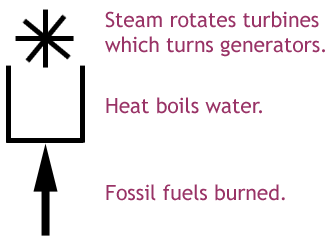Electricity Generation: Nuclear, Fossil Fuel and Wind
Edited by Jamie (ScienceAid Editor)
Electricity Generation
Generating Electricity
Electricity is a very important source of energy, being used to manufacture goods, keep medical equipment running, power our trains and of course to supply your electronic gadgets. However, this energy needs to be generated and then distributed.
There are many ways of generating electricity, and the way it is done varies globally depending on availability of resources, wealth, ecological concerns and so on. For example, in France 80% of electricity is generated by nuclear power, whilst in Brazil 80% is from hydropower. And electricity generation is a major political issue.
The two key social issues relating to electricity generation are cost since people will not buy expensive electricity and electric companies loose out. And the environment and particularly carbon emissions, since power plants contribute a large amount to these emissions. But there is also the issue of nuclear energy causing radioactive pollution.
Non-Renewable Sources
A non-renewable resource is one that cannot be replaced once it is used. fossil fuels are non-renewable and used widely to generate electricity by the following process.
Another resource for energy is nuclear power. This uses fuels such as uranium and plutonium; but instead of burning them, controlled fission reactions take place that release large amounts of energy that is used to heat water.
Nuclear power is better than fossil fuels since it doesn't produce carbon dioxide or sulphur dioxide pollution. However, it does produce radioactive waste, which must be disposed of carefully as it can cause health problems and can be used to make nuclear weapons.
Renewable Sources
Renewable sources of electricity generation are ones that can be used continuously, and ultimately all rely on the sun (wind is caused by the action of the sun). They have a much smaller impact on the environment but are a lot more expensive in the short term to install. The most widely used renewable source for electricity is hydro-power, and accounts for 10% of USA energy production.
We will look at wind power. This is an increasingly popular source of electricity, especially in the UK where construction of the world's largest wind farm, in the Thames Estuary is underway, and will provide enough energy for a quarter of London. The diagram below outlines wind power.
Referencing this Article
If you need to reference this article in your work, you can copy-paste the following depending on your required format:
APA (American Psychological Association)
Electricity Generation: Nuclear, Fossil Fuel and Wind. (2017). In ScienceAid. Retrieved Apr 20, 2024, from https://scienceaid.net/physics/electricity/generation.html
MLA (Modern Language Association) "Electricity Generation: Nuclear, Fossil Fuel and Wind." ScienceAid, scienceaid.net/physics/electricity/generation.html Accessed 20 Apr 2024.
Chicago / Turabian ScienceAid.net. "Electricity Generation: Nuclear, Fossil Fuel and Wind." Accessed Apr 20, 2024. https://scienceaid.net/physics/electricity/generation.html.
If you have problems with any of the steps in this article, please ask a question for more help, or post in the comments section below.
Comments
Article Info
Categories : Electricity





